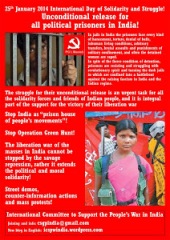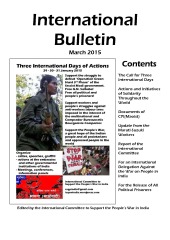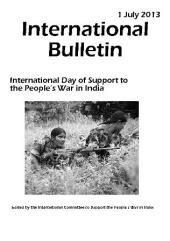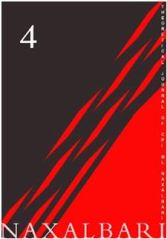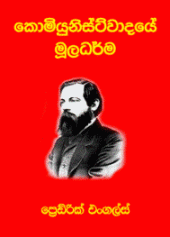Category Archives: North Korea
North Korea: the Real Concerns
North Korea: the Real Concerns
Mohan
[We have excerpted this article form New Democracy, #63, organ of the NDMLP]

Whenever North Korea announces the testing of a nuclear device or a ballistic missile, media respond with nervous concern that North Korea is taking the world to the brink of war. While it is the US that is seeking a pretext to wage war on North Korea by claiming that it constitutes a threat to Global Security, the impression created is that North Korea is a poverty stricken rouge state which indulges in military adventure to divert attention of its people from their problems by repeated reference to threats by the US and its client state in South Korea, and that North Korea thereby threatens world peace through its limited stock of nuclear weapons and missile delivery stems.
The concern expressed by the US officialdom and its docile media is that North Korea has acquired the means of an effective self-defence, which makes it a threat to the US. Such attitude is not new and has been the excuse for the US to threaten, subvert, attack and invade countries that it presents to its public as a threat to its security. The list of victims is long. However, Cuba, Iran and North Korea constitute the best remembered cases of prolonged unsuccessful victimization by the US.
It is important to know the history of the conflict in Korea to understand the true situation and recognize who poses a threat to whose existence in the standoff between the US and North Korea.
Division of Korea
North Korea, which is the most heavily sanctioned country, has been the victim of the wrath of the US from the time it frustrated US efforts to prevent socialism taking root in Korea after the liberation of the country from Japanese occupation in 1945. The US, fearing widespread popularity of the Korean revolution across Korea, immediately created the United States Army Military Government in Korea (USAMGIK) south of the 38th Parallel and made it the sole legal authority until the Republic of Korea (ROK) was formally established on 15thAugust 1948 in South Korea. The Democratic People’s Republic of Korea (DPRK) was formed in North Korea on 9th September 1948. Thus Korea was divided without consulting the people of Korea and the pledge of fair nationwide elections to enable reunification was not honoured.US military occupation of South Korea has continued despite its becoming a republic; and the US intervened in the elections to impose the right-wing nationalist, Syngman Rhee on South Korea. His murderous regime lasted until 26th April 1960, when he was overthrown by a weeklong protest by students opposing police violence and demanding fair elections.
The US used the bitterly anti-communist Syngman Rhee to provoke conflict with the North; and, contrary to the official Western version propagated by the dominant media that North Korea invaded South Korea on 25th June 1950, it was the South Korean forces that bombed the North Korean town of Haeju on 23rd and 24th June and announced its capture in the morning of 26th June. The New York Times admitted on June 26, 1950 that provocative pronouncements came from the South Korean regime and not the North. Thus North Korea was dragged into a war by the US using its glove puppet regime in Seoul.
The Korean War
North Korea was dragged into war by the US and named the aggressor by the UN, when the Soviet Union boycotted its General Assembly. With the Soviet Union lacking its veto in the Security Council, the US was able to use the name of the UN for its war on North Korea from 27th June 1950.
The US scored initial success by inflicting untold destruction on North Korea but failed to accomplish its mission of subduing North Korea. The war, besides, led to another humiliation of the US when it dragged China into the conflict in mid-October.
China entered the fray when US intervened to drive back the North Korean forces from the positions that they captured in the South and advance into the northernmost parts of North Korea. The Chinese and North Koreans together overcame the South Korean and US forces within weeks putting them on the retreat until January 1951, after which China expressed interest in bringing the conflict to an end. But that was rejected by war mongers of the US establishment like General MacArthur, who even threatened to use a nuclear bomb against North Korea. But Macarthur was soon relieved of his command post in Korea and peace talks started, much against the wishes of Syngman Rhee, at Kaesong on 10thJuly 1951 and continued in Panmunjom from 25th October. Armistice was signed on27th July 1953 with the 38th Parallel reset as boundary between the North and the US-dominated South. Cold War tensions continued unabated as the Armistice was not a peace treaty so that, in theory, the war has not ended.
The wanton damage inflicted by the armed forces of the US on the people of North Korea has been variously estimated. Between 20 and 30% of the North Korean population of a little over eight million were reported killed mainly by indiscriminate US bombing which destroyed 78 cities and thousands of villages and demolished nearly all power plants and most of the industry in North Korea.
US bombing of North Korea comprised 635,000 tons of bombs including 32,557 tons of napalm, compared to 503,000 tons of bombs dropped by the US in the entire Pacific theatre of World War II. (This record was surpassed several fold during the Vietnam War with napalm and Agent Orange defoliants usage exceeding napalm usage against North Korea by a factor of ten.)
Such wanton destruction is adequate basis for North Korea to view every move of the US in East Asia with strong suspicion. Actions of successive US governments have done little to diminish the fears of North Korea.
Keeping Korea Divided
North Korea was, however, very keen on the reunification of North and South Korea as were the people of both parts of the country divided by US imperialism. Reuniting the North and South by peaceful means would mean that the US will not be able to station its troops in South Korea for long as well as leave few excuses for the presence of US troops in East Asia including Japan. Hence the US was interested in not only keeping the country divided but also maintaining a permanent state of hostility between the divided parts.
Even Syngman Rhee, like Kim Il Sung, all along wanted a united Korea. A reunited Korea is the dream of all Koreans. The real obstacle to reunion has been the US which resents the idea of rapprochement between the North and the South and exerts pressure on South Korean heads of state whenever they seek closer ties with the North. Even today there is bitter conflict between US President Donald Trump and South Korean President Moon Jae-in about the need for dialogue with the North, unlike his corrupt predecessors Park Geun-hye and Lee Myung-bak who pursued hostility towards the North at the instigation of the US while paying lip service to reunification.
The global media works overtime to present an image of a democratic South Korea struggling against an aggressive North Korea which plans to destroy the South. A reading of the history of democracy in South Korea will dispel such illusion.
Syngman Rhee, the first ruler of South Korea was a dictator overthrown by student protest in 1960, only to be soon followed by direct military rule from 1961 to 1963 by General Park Chung Hee who got himself elected twice and in 1972 declared himself President for Life. His dictatorial regime ended in 1979 with his assassination. He was followed by the dictatorial regimes of Major General Chun Doo-Hwan (1980-1988) and General Roh Tae Woo (1988-1993).
Kim Young-sam, elected president in 1992,served as the first civilian president of the country from 1993 to 1998 and sought to improve relations with the North. He also ensured that the two former presidents, Chun Doo-Hwan and Roh Tae Woo, who were guilty of bribery and corruption, were sentenced to imprisonment. He was followed by Kim Dae-jung (1998-2003) whose actions to reconcile with North Korea culminated in reunions of the separated families of the Korean War and a summit talk with North Korea’s Leader Kim Jong Il. That was resented by the US and a hostile policy came into effect following the election of Lee Myung-bak as the next President and lasted even more vigorously through the presidency of Park Geun-hye who was formally impeached in 2017 for corruption. President Moon Jae-in who swore in on 10th May 2017, although desirous of friendly relations with the North, is constrained by the unhealthy climate created over the past 14 years.
The US has kept Korea divided by promoting the illusion that North Korea is a threat to the South; and the international media portray North Korea, the only country in recent history to lose a quarter of its population in war, as a threat to global security. The current theme is the nuclear threat posed by North Korea, ignoring the sources of such threat.
Nuclear Weapons in South Korea
South Korea admitted to the IAEA in 2004 that its scientists had secretly been enriching uranium. In the early 1970’s, fearing the effect of US troop reduction in South Korea, the Weapons Exploitation Committee of the government decided to develop nuclear weapons. The programme appears to have continued until October 1979. South Korea has admitted to secret activities that began in 1979 and continued through 1987 without declaration to the IAEA, in violation of its NPT commitments. Whether or not the scientists were working with higher-level approval is unknown. But the scientists belonged to the state funded Korea Atomic Energy Research Institute. [See: http://www.truth-out.org/news/item/41928-correcting-history-five-things-no-one-wants-to-say-about-korea]
South Korea, although not a producer of nuclear weapons, was provided with nuclear weapons by the US which decided on their type, quantity and location. The US Army deployed Nike Hercules surface-to-air missiles to South Korea in 1961 for possible use as surface-to-surface missiles to lay a carpet of radioactivity along the DMZ. Also in 1961 the US Army in South Korea added a surface to surface missile with a 200 kiloton nuclear warhead. Tactical nuclear recoilless rifles provided with nuclear artillery shells were in service in South Korea from 1962 to 1968.
At the height of the Cold War, US nuclear deployment in South Korea was approximately 950 weapons of all types. However, by the 1970s the US Army and Air Force had phased out all nuclear rockets, surface to surface missiles and cruise missiles from South Korea, leaving behind artillery shells and gravity bombs as the only tactical nuclear weapons, until removal of all nuclear weapons was ordered in 1991. The US arsenal of nuclear gravity bombs in South Korea had Air Force F-4D Phantom II fighter jets as delivery vehicles with tactical nuclear weapons deployed at a high state of readiness against surprise invasion by North Korea and for an all-out nuclear war. [See: https://scout.com/military/warrior/Article/The-History-of-US-Nuclear-Weapons-in-South-Korea-107229766]
Nuclear Build-up in North Korea
Not long after the Korean War the US was at war in Vietnam following the ignominious defeat of the French colonialists in 1954. US involvement grew to the point of committing US troops in 1965 and the war ended in a humiliating defeat for the US in 1975.
Besides, the 1970’s also saw strong anti-colonial and anti-imperialist upsurges in the Third World which put imperialism on the retreat. But US influence in East and South East Asia was strong among its allies such as Japan, Indonesia, Thailand, the Philippines, Taiwan and South Korea which fought alongside the US in Vietnam. However, threatening North Korea was not easy while a militarily strong Soviet Union sided with North Korea, which was also friendly with China. Yet, as explained earlier, the US stockpiled tactical nuclear weapons across South Korea until 1991. Despite US claims that it has no nuclear weapons in South Korea, it is likely that they are held in ships offshore.
North Korea’s interest in nuclear technology began in the 1950’s. It received knowledge and technology from the Soviet Union to found its Atomic and Nuclear Physics Research Institute in 1955. Agreement was made with the Soviet Union in September 1959on the use of nuclear power. A research reactor was set up in 1963 and became operational in 1965.Through subsequent independent research, North Korea upgraded its Soviet-built reactor to 8 MW and installed home-built power plants and uranium-ore processing and fuel-rod fabrication plants. North Korean light-water reactors met the growing demand for electric power.
In 1985, North Korea signed the Nuclear Non-Proliferation Treaty (NPT), but refused inspection of its nuclear sites by the International Atomic Energy Agency (IAEA) while nuclear weapons remained in South Korea. It was in this context that the US removed its nuclear stockpile in South Korea in 1991 so that pressure could be mounted on the North to prevent its developing nuclear weapons.
With the collapse of the Soviet Union, the US escalated its nuclear threat against North Korea, whose nuclear crisis began in February 1993when General Lee Butler, head of the US Strategic Command, announced that he was retargeting strategic nuclear weapons meant for the old USSR, on North Korea (among others).Also, CIA chief James Woolsey testified that North Korea was ‘our most grave current concern’ and by mid-March 1993, tens of thousands of US soldiers carried out war games in South Korea which involved B1-B bombers, B-52s and naval vessels carrying cruise missiles. North Korea, in response, pulled out of the NPT.[Bruce Cumings, Korea’s Place in the Sun: A Modern History, W.W. Norton & Co. 2005. pp 488-489 cited in https://gowans.wordpress.com/2017/07/05/the-real-reason-washington-is-worried-about-north-koreas-icbm-test/].
In 1994, North Korea signed the US-North Korea Agreed Framework with the United States and under the terms of the 1994 framework, North Korea agreed to freeze and ultimately dismantle its nuclear programme in exchange for full normalisation of political and economic relations with the US. This meant:
- By 2003, a US-led consortium would build two light-water nuclear reactors in North Korea to compensate for loss of nuclear power.
- Until then, the US would supply the North with 500,000 tons per year of heavy fuel.
- The US would lift sanctions, remove North Korea from its list of state sponsors of terrorism, and normalise the political relationship, which was still subject to the terms of the 1953 Korean War armistice.
- Finally, both sides would provide formal assurances against the threat or use of nuclear weapons.
Despite the testimony to the US Congress in 1998 by officials involved in implementing the agreement with the US and the IAEA agreeing that there had been “no fundamental violation of any aspect of the framework agreement” by North Korea, the US failed to honour its pledges.[Source: Maria Ryan in the Independent,http://www.independent.co.uk/voices/north-korea-missile-test-us-1994-agreed-framework-pyongyang-programme-kim-jong-un-donald-trump-a7876446.html]
In July 2005, following a meeting between the US Assistant Secretary of State for East Asian and Pacific Affairs and North Korean Vice Foreign Minister, North Korea announced its return to the six-party talks (involving North Korea, South Korea, China, Russia, Japan and the US) based on the understanding reached that the US side clarified its official stand to recognize North Korea as a sovereign state, not to invade it and hold bilateral talks within the framework of the six-party talks.
Agreements reached in 2005, like in 1994, bound the US to stop threats against North Korea, act to normalize relations, and plan work on a light-water reactor that would produce fuel but not weapons. But, as pointed out by Noam Chomsky (see ‘What We Say Goes: Conversations on U.S. Power in a Changing World’ by Noam Chomsky and David Barsamian, Metropolitan Books, 2007) diplomacy’s failure lay once again with the US and not North Korea. President Bush broke his light-water reactor promise and launched economic warfare on North Korea. In June 2008 North Korea stated that it had begun to dismantle its nuclear programme and declared that it would turn over all of its plans to the international community. But the six-party talks broke down in 2008 owing to the US insisting that international inspectors be allowed into North Korea with no assurance on its part about escalation of tension in the region. Clearly, the US did not want a negotiated peace in Korea which would mean an end to US military occupation of South Korea.
Complaints about the North Korea’s nuclear tests in 2006, 2009 and 2013 fail to take into account the provocative escalation of US military activity in the region and harassment through economic sanctions. North Korea has learned from history on how to deal with US imperialism. It realizes that the possession of nuclear weapons and ability to deliver them across a long distance comprise its only deterrent against attack by the US. It also realizes that it can rely on neither China nor Russia for its defence against US subversion and aggression.
US Threat to North Korea
The threat posed by the US since the Korean War is multi-faceted. The pretext for the annual South Korea-US joint military exercises― which North Korea accuses are preparations for war ―was until recently the security of South Korea. North Korea has repeatedly offered to freeze its nuclear and missile tests if the exercises are suspended. But the US and South Korea have kept rejecting the offer, claiming that the drills are legitimate defence exercises that have been conducted for decades.
The US maintains an elaborate system of military bases and locations throughout South Korea. Currently 37,000 US troops are stationed at 100 military installations, including four major Air Force bases, two naval bases and a number of US Army camps clustered in several locations. The headquarters base for the US-ROK combined forces, and the 8th US Army, is at Yongsan in downtown Seoul.
The US has escalated its economic war against North Korea by imposing a series of punitive sanctions in the past two decades besides what it pushes through the UN. The theme for the anti North Korea policy of the US has now been shifted with the help of an obliging media network from a threat to South Korea to nuclear threat against the world.
It should be noted that the US, besides using the nuclear threat against several countries, is the only country that launched a nuclear attack on another country. It also used highly radioactive depleted uranium in its war on Iraq and insists on the use of such material in future if necessary. Stubborn refusal by the US not to adopt a no-first-use policy regarding nuclear weapons and the arrogant declaration that it reserves the right to use nuclear weapons first in the case of conflict clearly show that the US is the real threat to the world.
North Korea’s Stand
It is claimed that North Korea refuses to negotiate away its nuclear weapons program. That is untrue. Recently, North Korea’s Deputy Ambassador Kim In-ryong clarified to the UN Secretary General António Guterres that “As long as the US hostile policy and nuclear threat continue, the DPRK, no matter who may say what, will never place its self-defensive nuclear deterrence on the negotiating table”. Thus North Korea only asserts that it will not negotiate away a deterrent until guarantees are there that obviate the need.
The fears of North Korea are based on reality. It was the US that violated the armistice agreement of 1953 which prohibited bringing new weapons into the Korean Peninsula by placing nuclear-tipped missiles in South Korea in 1958 which remained there for 33 years until 1991.
As a country traumatized by the wanton destruction by the US during Korean War, North Korea has been understandably sensitive to threats ranging from US nuclear missiles in South Korea and the clandestine South Korean nuclear weapons program, to explicit threats contained in the “Axis of Evil” declaration by the US and being named a country the US should be prepared to drop a nuclear bomb on. The threat has been kept alive by the US-South Korean military exercises on the North Korean border which include simulation of nuclear attacks on North Korea. Recent threats by President Donald Trump include a military option to destroy North Korea.
It was North Korea that took the initiative to propose denuclearization of the region. In 2014, President Obama rejected a North Korean offer to freeze missile testing if the US freezes its joint military exercises with South Korea. The offer was repeated in 2015 and again rejected.
In January 2017, North Korea offered to sit with the U.S. anytime to discuss US war games and its nuclear and ballistic missile programs. North Korea proposed that the US should contribute to easing tensions in the Korean peninsula by temporarily suspending joint military exercises in South Korea and its vicinity, in which case North Korea will take responsive steps such as temporarily suspending nuclear tests. The proposal was supported by China and Russia and later by South Korea’s new president Moon Jae-in. But the US rebuffed the proposal, refusing equivalence between ‘legitimate’ US-led war games and North Korea’s ‘illegitimate’ missile and nuclear tests.
The point to note is that North Korea, unlike Iraq under Saddam Hussein and Libya under Muammar Gaddafi, has successfully resisted the schemes of the US, which exercises a global dictatorship and claims the right to intervene in any part of the globe, in order that the US has total control over the political and economic affairs of countries.
The International Duty of Left and Progressive Forces
There is tendency among some on the Left to place on par the nuclear weapons programmes of the US and that of North Korea based on a desire for denuclearization. This ignores the context in which North Korea chose to develop nuclear weapons. It will be useful to consider why China chose to develop nuclear weapons in the early 1960’s. Development and possession of nuclear weapons by the US and North Korea differ not only in scale but also in their respective approaches to the use of nuclear weapons and nuclear disarmament.
The central issue concerns the continuing military threat against North Korea by US troops based in South Korea. Withdrawal of US military presence in South Korea is a precondition for peace in the region and for fulfilling the long cherished ambition of the people of the North and the South to reunite Korea as one country.
It is the moral responsibility of all left and progressive forces to defend North Korea against US attempts to subdue and control North Korea by undermining its economy using sanctions as a weapon. Thus there is need for a coordinated campaign demanding that the US stops its economic and military harassment of North Korea and puts an end to all military exercises in Korea and its waters.
Other Sources Used
William Blum: Killing Hope: US Military and CIA Interventions since World War II (Common Courage Press, 1995)
Michel Chossudovsky: https://www.globalresearch.ca/know-the-facts-north-korea-lost-close-to-30-of-its-population-as-a-result-of-us-bombings-in-the-1950s/22131
Stephen Gowans: (https://gowans.wordpress.com/2017/07/05/the-real-reason-washington-is-worried-about-north-koreas-icbm-test/)
William Polk: (https://consortiumnews.com/2017/08/28/how-history-explains-the-korean-crisis/)
Mike Whitney: http://www.counterpunch.org/2017/04/17/the-problem-is-washington-not-north-korea/
S Brian Willson: (http://www.brianwillson.com/history-of-u-s-sabotage-of-korean-peace-and-reunification/)
*****
ප්රචාරක යුද්ධය – Propaganda War
ප්රචාරක යුද්ධය – The Propaganda Game (2015)
උතුරු කොරියාව පිළිබඳ සත්ය සහ එක්සත් ජනපද CIA බොරු ප්රචාර පිළිබඳව දැන ගන්න..
Knows reality of the North Korea and Fake propaganda of US-CIA.
